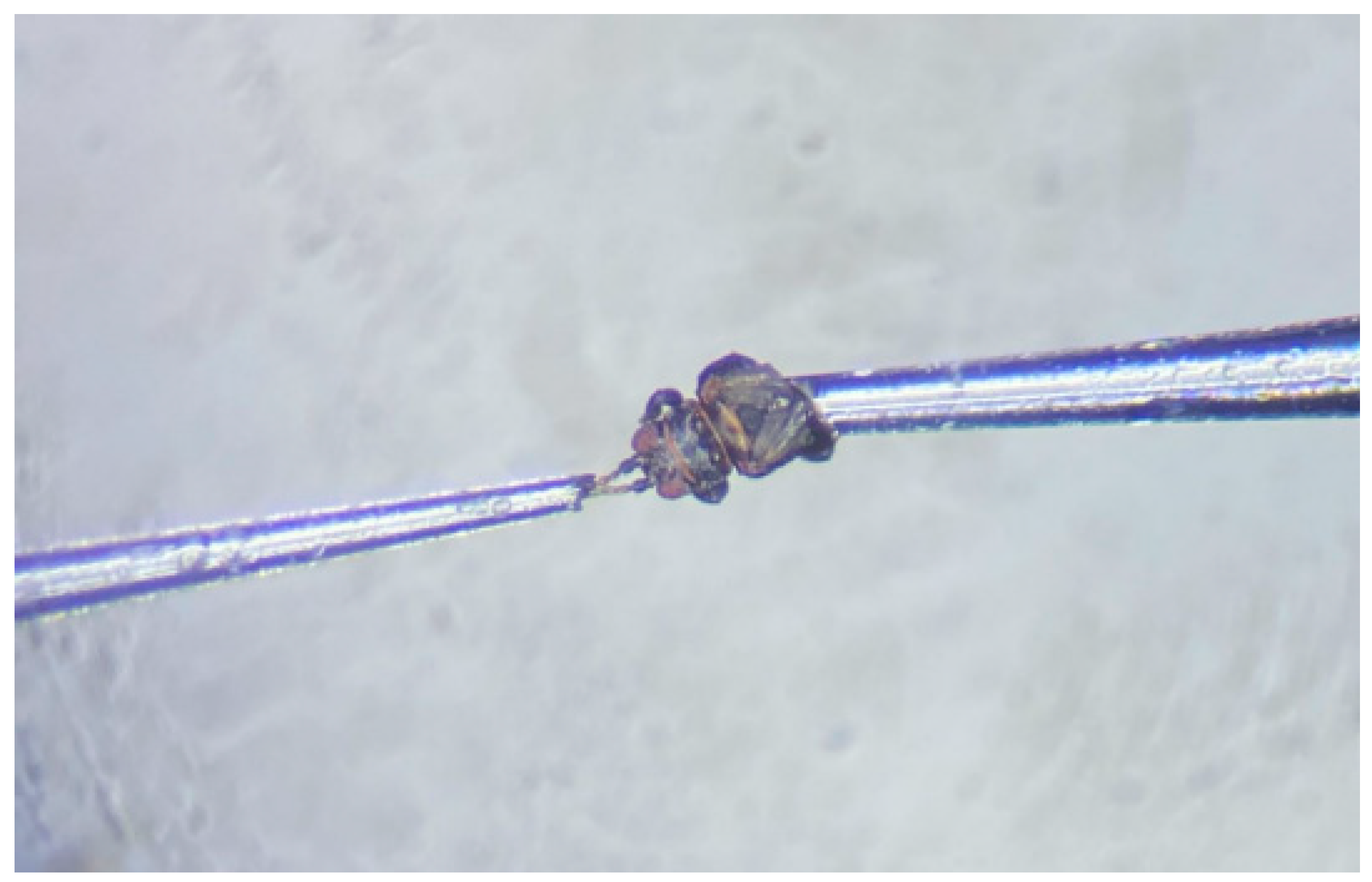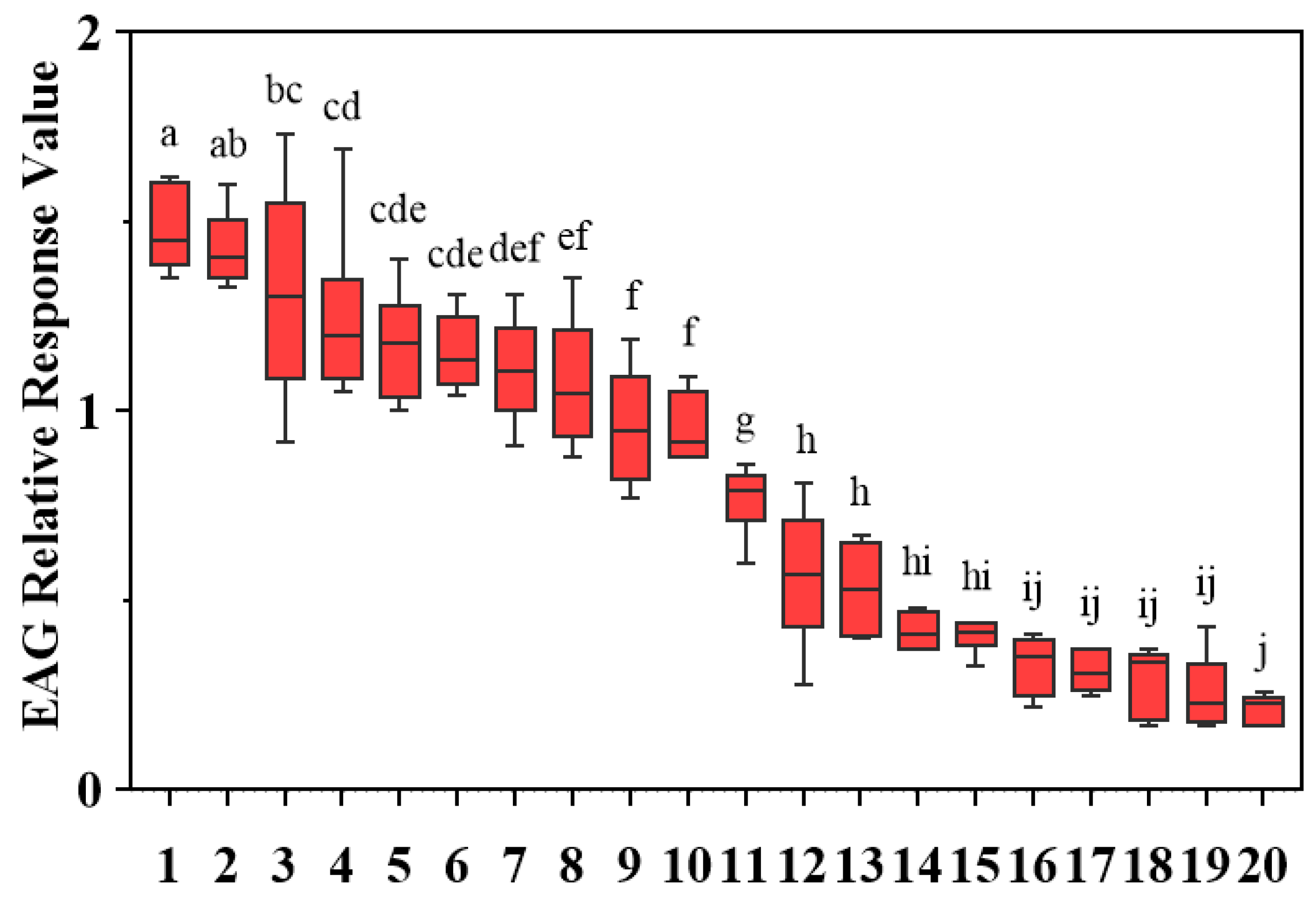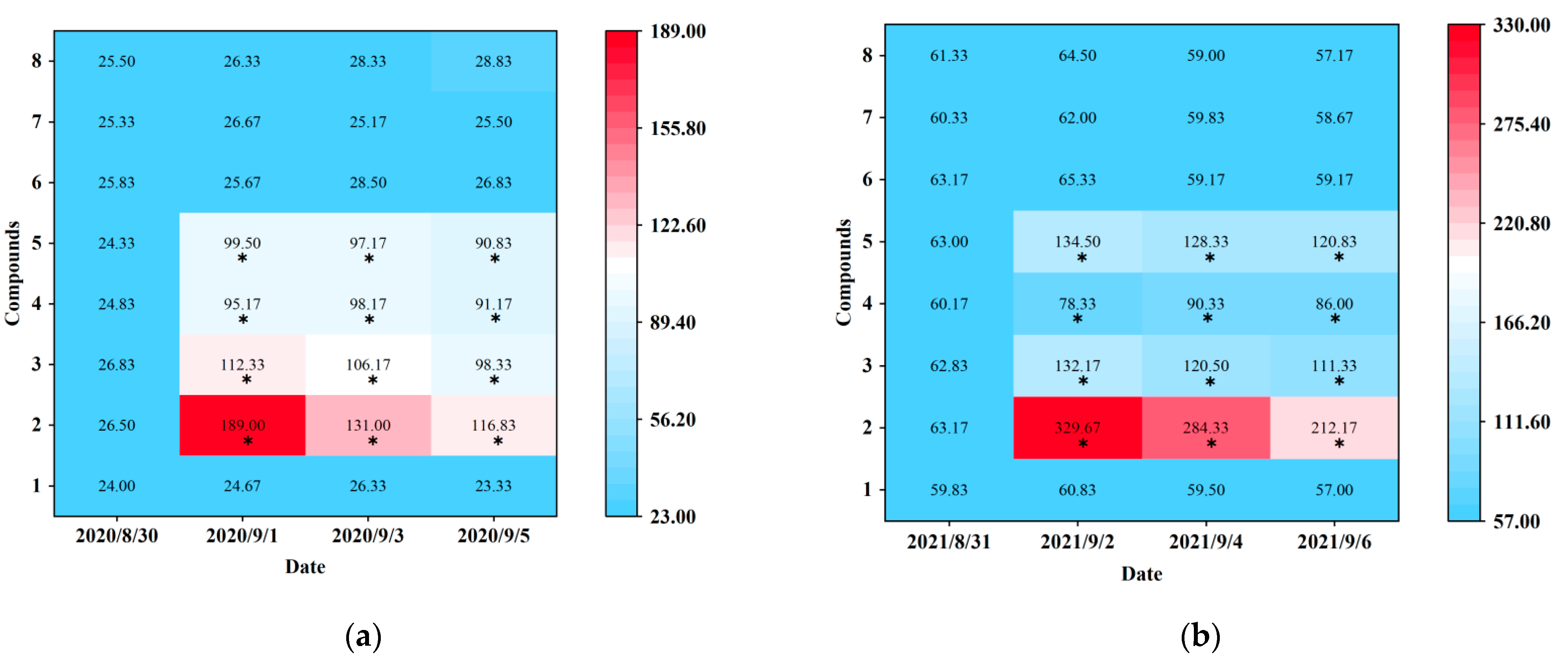Evaluation of Selected Plant Volatiles as Attractants for the Stick Tea Thrip Dendrothrips minowai in the Laboratory and Tea Plantation
Abstract
:Simple Summary
Abstract
1. Introduction
2. Materials and Methods
2.1. Biological Materials
2.2. Chemicals
2.3. Electrophysiological Recordings
2.4. H-Tube Olfactometer Bioassays
2.5. Field Trapping Trials
2.6. Statistical Analyses
3. Results
3.1. EAG Response of D. minowai Adults to Single Compound
3.2. Behavioral Response to Single Compound
3.3. Field Evaluation of Seven Compounds to Adult Thrips
4. Discussion
5. Conclusions
Supplementary Materials
Author Contributions
Funding
Institutional Review Board Statement
Data Availability Statement
Conflicts of Interest
References
- El-Ghany, N.M.A. Semiochemicals for controlling insect pests. J. Plant Protec. Res. 2019, 59, 1–11. [Google Scholar]
- Gaffke, A.M.; Alborn, H.T.; Dudley, T.L.; Bean, D.W. Using chemical ecology to enhance weed biological control. Insects 2021, 12, 695. [Google Scholar] [CrossRef] [PubMed]
- Gregg, P.C.; Socorro, A.P.; Landolt, P.J. Advances in attract-and-kill for agricultural pests: Beyond pheromones. Annu. Rev. Entomol. 2018, 63, 453–470. [Google Scholar] [CrossRef]
- Kirk, W.D.J.; de Kogel, W.J.; Koschier, E.H.; Teulon, D.A.J. Semiochemicals for thrips and their use in pest management. Annu. Rev. Entomol. 2021, 66, 101–119. [Google Scholar] [CrossRef] [PubMed]
- Nielsen, M.C.; Worner, S.P.; Rostás, M.; Chapman, R.B.; Butler, R.C.; de Kogel, W.J.; Teulon, D.A.J. Olfactory responses of western flower thrips (Frankliniella occidentalis) populations to a non-pheromone lure. Entomol. Exp. Appl. 2015, 156, 254–262. [Google Scholar] [CrossRef]
- Teulon, D.A.J.; Davidson, M.M.; Nielsen, M.; Butler, R.; Castañé, C. Efficacy of a non-pheromone semiochemical for trapping of western flower thrips in the presence of competing plant volatiles in a nectarine orchard. Span. J. Agric. Res. 2018, 16, e10SC01. [Google Scholar] [CrossRef]
- Walgenbach, J.F.; Schoof, S.C.; Dolors, B.; Lucia-Adriana, E.C.; Bill, L.; Grzegorz, K. Comparison of sex pheromone and kairomone-enhanced pheromone lures for monitoring oriental fruit moth (Lepidoptera: Tortricidae) in mating disruption and non-disruption tree fruit orchards. Environ. Entomol. 2021, 50, 1063–1074. [Google Scholar] [CrossRef]
- Teulon, D.A.J.; Castañé, C.; Nielsen, M.-C.; El-Sayed, A.M.; Davidson, M.M.; Gardner-Gee, R.; Poulton, J.; Kean, A.M.; Hall, C.; Butler, R.C.; et al. Evaluation of new volatile compounds as lures for western flower thrips and onion thrips in New Zealand and Spain. N. Z. Plant Prot. 2014, 67, 175–183. [Google Scholar] [CrossRef] [Green Version]
- Koschier, E.H. Essential oil compounds for thrips control: A review. Nat. Prod. Commun. 2008, 3, 1171–1182. [Google Scholar] [CrossRef] [Green Version]
- Teulon, D.A.J.; Davidson, M.M.; Perry, N.B.; Nielsen, M.C.; Castañé, C.; Bosch, D.; Riudavets, J.; van Tol, R.W.H.M.; de Kogel, W.J. Methyl isonicotinate-a non-pheromone thrips semiochemical-and its potential for pest management. Int. J. Trop. Insect Sci. 2017, 37, 50–56. [Google Scholar] [CrossRef]
- Murai, T.; Imai, T.; Maekawa, M. Methyl anthranilate as an attractant for two thrips species and the thrips parasitoid Ceranisus menes. J. Chem. Ecol. 2000, 26, 2557–2565. [Google Scholar] [CrossRef]
- Imai, T.; Maekawa, M.; Murai, T. Attractiveness of methyl anthranilate and its related compounds to the flower thrips, Thrips hawaiiensis (Morgan), T. coloratus Schmutz, T. flavus Schrank and Megalurothrips distalis (Karny) (Thysanoptera: Thripidae). Appl. Entomol. Zool. 2001, 36, 475–478. [Google Scholar] [CrossRef] [Green Version]
- Katerinopoulos, H.E.; Pagona, G.; Afratis, A.; Stratigakis, N.; Roditakis, N. Composition and insect attracting activity of the essential oil of Rosmarinus officinalis. J. Chem. Ecol. 2005, 31, 111–122. [Google Scholar] [CrossRef]
- Koschier, E.; Nielsen, M.-C.; Spangl, B.; Davidson, M.M.; Teulon, D.A.J. The effect of background plant odours on the behavioural responses of Frankliniella occidentalis to attractive or repellent compounds in a Y-tube olfactometer. Entomol. Exp. Appl. 2017, 163, 160–169. [Google Scholar] [CrossRef]
- Koschier, E.H.; Kogel, W.J.; Visser, J.H. Assessing the attractiveness of volatile plant compounds to western flower thrips Frankliniella occidentalis. J. Chem. Ecol. 2000, 26, 2643–2655. [Google Scholar] [CrossRef]
- Terry, I.; Walter, G.H.; Moore, C.; Roemer, R.; Hull, C. Odor-mediated push-pull pollination in cycads. Science 2007, 318, 70. [Google Scholar] [CrossRef] [PubMed] [Green Version]
- Avellaneda, J.; Diaz, M.; Coy-Barrera, E.; Rodriguez, D.; Osorio, C. Rose volatile compounds allow the design of new control strategies for the western flower thrips (Frankliniella occidentalis). J. Pest Sci. 2019, 94, 124–142. [Google Scholar] [CrossRef]
- Broughton, S.; Cousins, D.A.; Rahman, T. Evaluation of semiochemicals for their potential application in mass trapping of Frankliniella occidentalis, (Pergande) in roses. Crop Prot. 2015, 67, 130–135. [Google Scholar] [CrossRef]
- Broughton, S.; Harrison, J. Evaluation of monitoring methods for thrips and the effect of trap colour and semiochemicals on sticky trap capture of thrips (Thysanoptera) and beneficial insects (Syrphidae, Hemerobiidae) in deciduous fruit trees in western Australia. Crop Prot. 2012, 42, 156–163. [Google Scholar] [CrossRef]
- Lyu, Z.Y.; Zhi, J.R.; Zhou, Y.F.; Meng, Z.H.; Yue, W.B. Genetic diversity and origin of Dendrothrips minowai (Thysanoptera: Thripidae) in Guizhou, China. J. Asia-Pac. Entomol. 2016, 19, 1035–1042. [Google Scholar] [CrossRef]
- Bian, L.; Yang, P.X.; Yao, Y.J.; Luo, Z.X.; Cai, X.M.; Chen, Z.M. Effect of trap color, height, and orientation on the capture of yellow and stick tea thrips (Thysanoptera: Thripidae) and nontarget insects in tea gardens. J. Econ. Entomol. 2016, 109, 1241–1248. [Google Scholar] [CrossRef] [PubMed]
- Chen, S.C.; Jiang, H.Y.; Peng, P.; Hu, X.; Wang, X.Q. The complete mitochondrial genome of the stick tea thrips Dendrothrips minowai (Thysanoptera: Thripidae). Mitochondrial DNA Part B 2018, 3, 58–59. [Google Scholar] [CrossRef] [PubMed] [Green Version]
- Zhang, C.R.; Liu, M.; Ban, F.X.; Shang, X.L.; Liu, S.L.; Mao, T.T.; Zhang, X.Y.; Zhi, J.R. Establishment of a faba bean banker plant system with predator Orius strigicollis for the control of thrips Dendrothrips minowai on tea plants under laboratory conditions. Insects 2021, 12, 397. [Google Scholar] [CrossRef]
- Sun, X.L.; Li, X.W.; Xin, Z.J.; Han, J.J.; Ran, W.; Lei, S. Development of synthetic volatile attractant for male Ectropis obliqua moths. J. Integr. Agric. 2016, 15, 1532–1539. [Google Scholar] [CrossRef]
- Chen, K.; Huang, M.X.; Shi, Q.C.; Xie, X.; Jin, L.H.; Xu, W.M.; Li, X.Y. Screening of a potential leafhopper attractants and their applications in tea plantations. J. Environ. Sci. Health Part B 2019, 54, 858–865. [Google Scholar] [CrossRef] [PubMed]
- Jing, T.T.; Qian, X.N.; Du, W.K.; Gao, T.; Li, D.F.; Guo, D.Y.; He, F.; Yu, W.K.; Li, S.P.; Wan, X.C.; et al. Herbivore-induced volatiles influence moth preference by increasing the β-Ocimene emission of neighbouring tea plants. Plant Cell Environ. 2021, 44, 3667–3680. [Google Scholar] [CrossRef] [PubMed]
- Bian, L.; Cai, X.M.; Luo, Z.X.; Li, Z.Q.; Xin, Z.J.; Chen, Z.M. Design of an attractant for Empoasca onukii (Hemiptera: Cicadellidae) based on the volatile components of fresh tea leaves. J. Econ. Entomol. 2018, 111, 629–636. [Google Scholar] [CrossRef]
- Ye, G.Y.; Xiao, Q.; Chen, M.; Chen, X.X.; Yuan, Z.J.; Stanley, D.W.; Hu, C. Tea: Biological control of insect and mite pests in China. Biol. Control 2014, 68, 73–91. [Google Scholar] [CrossRef]
- Nakai, M.; Lacey, L.A. Microbial control of insect pests of tea and coffee. Microb. Control Insect Mite Pests 2017, 15, 223–235. [Google Scholar]
- Vuts, J.; Woodcock, C.M.; Sumner, M.E.; Caulfield, J.C.; Reed, K.; Inward, D.J.; Leather, S.R.; Pickett, J.A.; Birkett, M.A.; Denman, S. Responses of the two-spotted oak buprestid, Agrilus biguttatus (Coleoptera: Buprestidae), to host tree volatiles. Pest Manag. Sci. 2016, 72, 845–851. [Google Scholar] [CrossRef] [Green Version]
- Xiu, C.L.; Pan, H.S.; Liu, B.; Luo, Z.X.; Williams, L.; Yang, Y.Z.; Lu, Y.H. Perception of and behavioral responses to host plant volatiles for three Adelphocoris Species. J. Chem. Ecol. 2019, 45, 779–788. [Google Scholar] [CrossRef] [PubMed]
- Xie, J.X.; Liu, T.H.; Yi, C.Q.; Liu, X.X.; Tang, H.Y.; Sun, Y.; Shi, W.P.; Khashaveh, A.; Zhang, Y.J. Antenna-biased odorant receptor hvaror25 in Hippodamia variegata tuned to allelochemicals from hosts and habitat involved in perceiving preys. J. Agric. Food Chem. 2022, 70, 1090–1100. [Google Scholar] [CrossRef] [PubMed]
- Luo, Z.X.; Li, Z.Q.; Cai, X.M.; Bian, L.; Chen, Z.M. Evidence of premating isolation between two sibling moths: Ectropis grisescens and Ectropis obliqua (Lepidoptera: Geometridae). J. Econ. Entomol. 2017, 110, 2364–2370. [Google Scholar] [CrossRef] [PubMed]
- Duan, S.G.; Li, D.Z.; Wang, M.Q. Chemosensory proteins used as target for screening behaviourally active compounds in the rice pest Cnaphalocrocis medinalis (Lepidoptera: Pyralidae). Insect Mol. Biol. 2019, 28, 123–135. [Google Scholar] [CrossRef] [PubMed] [Green Version]
- González-Orellana, J.; López-Guillén, G.; Malo, E.A.; Goldarazena, A.; Cruz-López, L. Behavioural and electrophysiological responses of Liothrips jatrophae (Thysanoptera: Phlaeothripidae) to conspecific extracts and some of its identified compounds. Phisiol. Entomol. 2022, 47, 11–19. [Google Scholar] [CrossRef]
- Cai, X.M.; Bian, L.; Xu, X.X.; Luo, Z.X.; Li, Z.Q.; Chen, Z.M. Field background odour should be taken into account when formulating a pest attractant based on plant volatiles. Sci. Rep. 2017, 7, 41818. [Google Scholar] [CrossRef] [Green Version]
- Bruce, T.J.; Pickett, J.A. Perception of plant volatile blends by herbivorous insects-fnding the right mix. Phytochemistry 2011, 72, 1605–1611. [Google Scholar] [CrossRef]
- Way, M.J.; Emden, H.F. Integrated pest management in practice-pathways towards successful application. Crop Prot. 2000, 19, 81–103. [Google Scholar] [CrossRef]
- Teulon, D.A.J.; Penman, D.R.; Ramakers, P.M.J. Volatile chemicals for thrips (Thysanoptera: Thripidae) host-finding and applications for thrips pest management. J. Econ. Entomol. 1993, 86, 1405–1415. [Google Scholar] [CrossRef]
- Teulon, D.A.J.; Davidson, M.M.; Hedderley, D.I.; James, D.E.; Fletcher, C.D.; Larsen, L.; Green, V.C.; Perry, N.B. 4-Pyridyl carbonyl and related compounds as thrips lures: Effectiveness for onion thrips and New Zealand flower thrips in field experiments. J. Agric. Food Chem. 2007, 55, 6198–6205. [Google Scholar] [CrossRef]
- Liu, P.P.; Qin, Z.F.; Feng, M.Y.; Zhang, L.; Huang, X.Z.; Shi, W.P. The male-produced aggregation pheromone of the bean flower thrips Megalurothrips usitatus in China: Identification and attraction of conspecifics in the laboratory and field. Pest Manag. Sci. 2020, 76, 2986–2993. [Google Scholar] [CrossRef]
- Teulon, D.A.J.; Hollister, B.; Butler, R.C.; Cameron, E.A. Colour and odour responses of flying western flower thrips: Wind tunnel and greenhouse experiments. Entomol. Exp. Appl. 1999, 93, 9–19. [Google Scholar] [CrossRef]
- Landolt, P.J.; Adams, T.; Zack, R.S. Field response of alfalfa looper and cabbage looper moths (Lepidoptera: Noctuidae, Plusiinae) to single and binary blends of floral odorants. Environ. Entomol. 2006, 35, 276–281. [Google Scholar] [CrossRef] [Green Version]
- Pinero, J.C.; Dorn, S. Synergism between aromatic compounds and green leaf volatiles derived from the host plant underlies female attraction in the oriental fruit moth. Entomol. Exp. Appl. 2007, 125, 185–194. [Google Scholar] [CrossRef]
- Gregg, P.C.; Socorro, A.P.; Henderson, G.S. Development of a synthetic plant volatile-based attracticide for female noctuid moths. II. Bioassays of synthetic plant volatiles as attractants for the adults of the cotton bollworm, Helicoverpa armigera (Hübner) (Lepidoptera: Noctuidae). Aust. J. Entomol. 2010, 49, 21–30. [Google Scholar] [CrossRef]
- Wogin, M.J.; Butler, R.C.; Teulon, D.A.J.; Davidson, M.M. Field response of onion thrips and New Zealand flower thrips to single and binary blends of thrips lures. Can. Entomol. 2010, 142, 75–79. [Google Scholar] [CrossRef]
- Binyameen, M.; Ejaz, M.; Shad, S.A.; Razaq, M.; Shah, R.M.; Schlyter, F. Eugenol, a plant volatile, synergizes the effect of the thrips attractant, ethyl iso-nicotinate. Environ. Entomol. 2018, 47, 1560–1564. [Google Scholar] [CrossRef]





Publisher’s Note: MDPI stays neutral with regard to jurisdictional claims in published maps and institutional affiliations. |
© 2022 by the authors. Licensee MDPI, Basel, Switzerland. This article is an open access article distributed under the terms and conditions of the Creative Commons Attribution (CC BY) license (https://creativecommons.org/licenses/by/4.0/).
Share and Cite
Xiu, C.; Zhang, F.; Pan, H.; Bian, L.; Luo, Z.; Li, Z.; Fu, N.; Cai, X.; Chen, Z. Evaluation of Selected Plant Volatiles as Attractants for the Stick Tea Thrip Dendrothrips minowai in the Laboratory and Tea Plantation. Insects 2022, 13, 509. https://doi.org/10.3390/insects13060509
Xiu C, Zhang F, Pan H, Bian L, Luo Z, Li Z, Fu N, Cai X, Chen Z. Evaluation of Selected Plant Volatiles as Attractants for the Stick Tea Thrip Dendrothrips minowai in the Laboratory and Tea Plantation. Insects. 2022; 13(6):509. https://doi.org/10.3390/insects13060509
Chicago/Turabian StyleXiu, Chunli, Fengge Zhang, Hongsheng Pan, Lei Bian, Zongxiu Luo, Zhaoqun Li, Nanxia Fu, Xiaoming Cai, and Zongmao Chen. 2022. "Evaluation of Selected Plant Volatiles as Attractants for the Stick Tea Thrip Dendrothrips minowai in the Laboratory and Tea Plantation" Insects 13, no. 6: 509. https://doi.org/10.3390/insects13060509
APA StyleXiu, C., Zhang, F., Pan, H., Bian, L., Luo, Z., Li, Z., Fu, N., Cai, X., & Chen, Z. (2022). Evaluation of Selected Plant Volatiles as Attractants for the Stick Tea Thrip Dendrothrips minowai in the Laboratory and Tea Plantation. Insects, 13(6), 509. https://doi.org/10.3390/insects13060509




